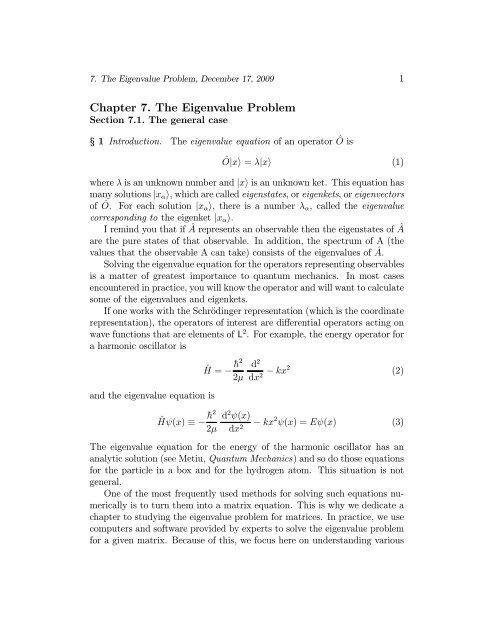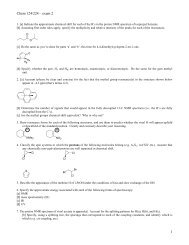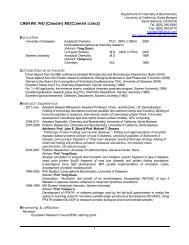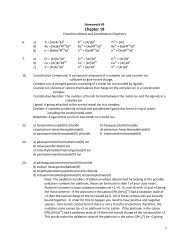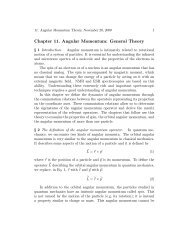Chapter 7. The Eigenvalue Problem
Chapter 7. The Eigenvalue Problem
Chapter 7. The Eigenvalue Problem
Create successful ePaper yourself
Turn your PDF publications into a flip-book with our unique Google optimized e-Paper software.
<strong>7.</strong> <strong>The</strong> <strong>Eigenvalue</strong> <strong>Problem</strong>, December 17, 2009 1<br />
<strong>Chapter</strong> <strong>7.</strong> <strong>The</strong> <strong>Eigenvalue</strong> <strong>Problem</strong><br />
Section <strong>7.</strong>1. <strong>The</strong> general case<br />
§ 1 Introduction. <strong>The</strong> eigenvalue equation of an operator Ô is<br />
Ô|x = λ|x (1)<br />
where λ is an unknown number and |x is an unknown ket. This equation has<br />
many solutions |x α , which are called eigenstates,oreigenkets,oreigenvectors<br />
of Ô. For each solution |x α ,thereisanumberλ α , called the eigenvalue<br />
corresponding to the eigenket |x α .<br />
I remind you that if  represents an observable then the eigenstates of Â<br />
are the pure states of that observable. In addition, the spectrum of A (the<br />
values that the observable A can take) consists of the eigenvalues of Â.<br />
Solving the eigenvalue equation for the operators representing observables<br />
is a matter of greatest importance to quantum mechanics. In most cases<br />
encountered in practice, you will know the operator and will want to calculate<br />
some of the eigenvalues and eigenkets.<br />
If one works with the Schrödinger representation (which is the coordinate<br />
representation), the operators of interest are differential operators acting on<br />
wave functions that are elements of L 2 . For example, the energy operator for<br />
a harmonic oscillator is<br />
and the eigenvalue equation is<br />
Ĥψ(x) ≡−¯h2<br />
2μ<br />
Ĥ = − ¯h2<br />
2μ<br />
d 2<br />
dx 2 − kx2 (2)<br />
d 2 ψ(x)<br />
dx 2 − kx 2 ψ(x) =Eψ(x) (3)<br />
<strong>The</strong> eigenvalue equation for the energy of the harmonic oscillator has an<br />
analytic solution (see Metiu, Quantum Mechanics) and so do those equations<br />
for the particle in a box and for the hydrogen atom. This situation is not<br />
general.<br />
One of the most frequently used methods for solving such equations numerically<br />
is to turn them into a matrix equation. This is why we dedicate a<br />
chapter to studying the eigenvalue problem for matrices. In practice, we use<br />
computers and software provided by experts to solve the eigenvalue problem<br />
for a given matrix. Because of this, we focus here on understanding various
<strong>7.</strong> <strong>The</strong> <strong>Eigenvalue</strong> <strong>Problem</strong>, December 17, 2009 2<br />
aspects of the eigenvalue problem for matrices and do not discuss numerical<br />
methods for solving it. When we need a numerical solution, we use<br />
Mathematica. For demanding calculations, we must use Fortran, C, orC++,<br />
since Mathematica is less efficient. <strong>The</strong>se computer languages have libraries<br />
of programs designed to give you the eigenvalues and the eigenvectors when<br />
you give them the matrix.<br />
§ 2 Some general considerations. It turns out that the eigenvalue problem<br />
A|ψ = λ|ψ has many solutions and not all of them are physically meaningful.<br />
We are interested in this eigenvalue problem because, if it arises<br />
from an observable, the eigenvalues are the spectrum of the observable and<br />
some of the eigenfunctions are the pure states of the observable. In addition,<br />
the operator representing the observable is Hermitian, because its spectrum,<br />
which consists of all the values the observable can take, just contain only real<br />
numbers.<br />
Before we try to solve the eigenvalue problem, we need to decide how<br />
we recognize which eigenstates correspond to pure states: these are the only<br />
eigenstates of interest to us.<br />
In <strong>Chapter</strong> 2, we examined the definition of the probability and concluded<br />
that kets |a i and |a j representing pure states must satisfy the orthonormalization<br />
condition<br />
a i | a j = δ ij (4)<br />
§ 3 Normalization. Let us assume that we are interested in solving the<br />
eigenvalue equation<br />
Â|ψ = λ|ψ (5)<br />
It is easy to see that if α is a complex number and |ψ satisfies Eq. 5 then<br />
|η = α|ψ satisfies the same equation. For every given eigenvalue we have<br />
as many eigenstates as complex numbers. <strong>The</strong> one that is a pure state must<br />
be normalized. We can therefore determine the value of α by requiring that<br />
|η satisfies<br />
η | η =1 (6)<br />
Using Eq. 5 in Eq. 6 (and the properties of the scalar product) leads to<br />
α ∗ αψ | ψ =1 (7)<br />
or<br />
α ∗ α = 1<br />
ψ | ψ<br />
(8)
<strong>7.</strong> <strong>The</strong> <strong>Eigenvalue</strong> <strong>Problem</strong>, December 17, 2009 3<br />
This gives<br />
α =<br />
e iφ<br />
<br />
ψ | ψ<br />
(9)<br />
where φ is a real number, which cannot be determined by solving Eq. 8. <strong>The</strong><br />
ket<br />
e iφ<br />
|η = |ψ (10)<br />
ψ | ψ<br />
is normalized and therefore is a pure state of  corresponding to the eigenvalue<br />
λ. If the system is in the state |η and we measure A, we are certain<br />
that the result is λ.<br />
In practice, most computer programs that calculate eigenstates do not<br />
normalize them. If the computer produces |ψ as the eigenket corresponding<br />
to eigenvalue λ, youmustuseEq.10tofind the eigenstate |η that is a pure<br />
state. Since e iφ in Eq. 10 is an irrelevant phase factor, we can drop it (i.e. take<br />
φ = 0); the pure state corresponding to λ is<br />
|η =<br />
|ψ <br />
ψ | ψ<br />
(11)<br />
§ 4 Orthogonality. <strong>The</strong> pure states must also be orthogonal. Because an<br />
operator Â, representing an observable A, is always Hermitian, one can prove<br />
that eigenstates corresponding to different eigenvalues must be orthogonal.<br />
That is, if<br />
Â|η i = λ i |η i and Â|η j = λ j |η j (12)<br />
and<br />
then<br />
<strong>The</strong>proofiseasy.Wehave<br />
λ i = λ j (13)<br />
η i | η j =0 (14)<br />
Âη i | η j −η i | Âη j =0 (15)<br />
because  is Hermitian. Using Eqs. 12 in Eq. 15 gives<br />
(λ i − λ j )η i | η j =0
<strong>7.</strong> <strong>The</strong> <strong>Eigenvalue</strong> <strong>Problem</strong>, December 17, 2009 4<br />
When λ i = λ j ,wemusthave<br />
η i | η j =0,<br />
which is what we wanted to prove.<br />
So, when you solve an eigenvalue equation for an observable, the eigenstates<br />
corresponding to different eigenvalues must be orthogonal. If they are<br />
not, there is something wrong with the program calculating the eigenvectors.<br />
What happens if some eigenvalues are equal to each other Physicists<br />
call such eigenvalues ‘degenerate’, mathematicians call them ‘multiple’. If |η i <br />
and |η j belong to the same eigenvalue (i.e. if Â|η i = λ|η i and Â|η j = λ|η j )<br />
then |η i and |η j are under no obligation to be orthogonal to each other (only<br />
to, according to the fact in the previous §, all eigenvectors belonging to eigenvalues<br />
that differ from λ). Most numerical procedures for solving eigenvalue<br />
problems will provide non-orthogonal degenerate eigenvectors. <strong>The</strong>se can be<br />
orthogonalized with the Gram-Schmidt procedure and then normalized. <strong>The</strong><br />
resulting eigenvectors are now pure states. You will see how this is done in<br />
an example given later in this chapter.<br />
It is important to keep in mind this distinction between eigenstates and<br />
pure states. All pure states are eigenstates but not all eigenstates are pure<br />
states.<br />
§ 5 <strong>The</strong> eigenvalue problem in matrix representation: a review. Let |a 1 ,<br />
|a 2 , ..., |a n , ...be a complete orthonormal basis set. This set need not be<br />
a set of pure states of an observable; we can use any complete basis set that<br />
a mathematician can construct. Orthonormality means that<br />
Because the set is complete, we have<br />
a i | a j = δ ij for all i, j (16)<br />
Î <br />
N<br />
|a n a n | (17)<br />
n=1<br />
Eq. 17 ignores the continuous spectrum and truncates the infinite sum in the<br />
completeness relation.<br />
We can act with each a m |, m =1, 2,...,N, on the eigenvalue equation<br />
to turn it into the following N equations:<br />
a m | Â | ψ = λa m | ψ, m =1, 2,...,N (18)
<strong>7.</strong> <strong>The</strong> <strong>Eigenvalue</strong> <strong>Problem</strong>, December 17, 2009 5<br />
Now insert Î, asgivenbyEq.17,between and |ψ to obtain<br />
N<br />
a m | Â | a na n | ψ = λa m | ψ, m =1, 2,...,N (19)<br />
n=1<br />
<strong>The</strong> complex numbers a n | ψ are the coordinates of |ψ in the {|a n } N n=1<br />
representation. If we know them, we can write |ψ as<br />
|ψ =<br />
N<br />
|a n a n | ψ (20)<br />
n=1<br />
It is easy to rewrite Eq. 19 in a form familiar from linear matrix algebra.<br />
Let us denote<br />
ψ i ≡a i | ψ, i =1, 2,...,N (21)<br />
and<br />
A mn ≡a m | Â | a n (22)<br />
With this notation, Eq. 19 becomes<br />
and Eq. 20,<br />
N<br />
A mn ψ n = λψ m , m =1, 2,...,N (23)<br />
n=1<br />
|ψ =<br />
N<br />
|a n ψ n (24)<br />
n=1<br />
<strong>The</strong> sum in Eq. 23 is the rule by which the matrix A, having the elements<br />
A mn , acts on the vector ψ, having the coordinates ψ n . This equation is called<br />
the eigenvalue problem for the matrix A and it is often written as<br />
Aψ = λψ (25)<br />
(which resembles the operator equation Â|ψ = λ|ψ) oras<br />
⎛<br />
⎞ ⎛ ⎞ ⎛<br />
A 11 A 12 ··· A 1N ψ 1 ψ 1<br />
A 21 A 22 ··· A 2N<br />
ψ 2<br />
⎜<br />
⎝ . .<br />
.. .<br />
⎟ ⎜ ⎟<br />
. ⎠ ⎝ .<br />
= λ ψ 2<br />
⎜<br />
⎠ ⎝ .<br />
A N1 A N2 ··· A NN<br />
ψ N<br />
ψ N<br />
⎞<br />
⎟<br />
⎠<br />
(26)<br />
Eqs. 25 and 26 are different ways of writing Eq. 23, which, in turn, is the<br />
representation of the equation Â|ψ = λ|ψ in the basis set {|a 1,...,|a N }.
<strong>7.</strong> <strong>The</strong> <strong>Eigenvalue</strong> <strong>Problem</strong>, December 17, 2009 6<br />
Normally in quantum mechanics we choose the basis set {|a 1 ,...,|a n }<br />
and know the operator Â. This means that we can calculate A mn = a m | Â | a n.<br />
We do not know |ψ or λ, and our mission is to find them from Â|ψ = λ|ψ.<br />
We have converted this operator equation, by using the orthonormal basis<br />
set {|a 1 ,...,|a N }, into the matrix equation Eq. 23 (or Eq. 25 or Eq. 26).<br />
In Eq. 23, we know A mn but we do not know ψ = {ψ 1 , ψ 2 ,...,ψ N } or λ.<br />
WemustcalculatethemfromEq.23.Onceweknowψ 1 , ψ 2 ,...,ψ N ,wecan<br />
calculate |ψ from<br />
|ψ =<br />
N<br />
|a n a n | ψ ≡<br />
n=1<br />
N<br />
ψ n |a n (27)<br />
§ 6 Use a computer. Calculating eigenvalues and eigenvectors of a matrix<br />
“by hand” is extremely tedious, especially since the dimension N is often very<br />
large. Most computer languages (including Fortran, C, C++, Mathematica,<br />
Maple, Mathcad, Basic) have libraries of functions that given a matrix will<br />
return its eigenvalues and eigenvectors.<br />
I will not discuss the numerical algorithms used for finding eigenvalues.<br />
Quantum mechanics could leave that to experts without suffering much harm.<br />
<strong>The</strong> Mathematica file Linear algebra for quantum mechanics.nb shows<br />
how to use Mathematica to perform calculations with vectors and matrices.<br />
Nevertheless, it is important to understand some of the theory related<br />
to the eigenvalue problem, since much of quantum mechanics relies on it. I<br />
presentsomeofitinwhatfollows.<br />
§ 7 <strong>The</strong> eigenvalue problem and systems of linear equations. <strong>The</strong> eigenvalue<br />
problem Eq. 23 can be written as<br />
n=1<br />
or<br />
⎛<br />
⎜<br />
⎝<br />
N<br />
(A mn − λδ mn )ψ n =0, m =1, 2,...,N (28)<br />
n=1<br />
A 11 − λ A 12 A 13 ··· A 1N<br />
A 21 A 22 − λ A 23 ··· A 2N<br />
A 31 A 32 A 33 − λ ··· A 3N<br />
. . .<br />
. . . .<br />
A N1 A N2 A N3 ··· A NN − λ<br />
⎞ ⎛<br />
⎟ ⎜<br />
⎠ ⎝<br />
ψ 1<br />
ψ 2<br />
ψ 3<br />
.<br />
ψ N<br />
⎞ ⎛<br />
=<br />
⎟ ⎜<br />
⎠ ⎝<br />
0<br />
0<br />
0.<br />
0<br />
⎞<br />
⎟<br />
⎠<br />
d<br />
= 0<br />
(29)
<strong>7.</strong> <strong>The</strong> <strong>Eigenvalue</strong> <strong>Problem</strong>, December 17, 2009 7<br />
<strong>The</strong> column in the right-hand side is the zero vector. We can regard δ mn<br />
asbeingtheelementsofamatrixI, which is called the unit matrix (or the<br />
identity matrix):<br />
⎛<br />
⎞<br />
1 0 0 ······ 0<br />
0 1 0 ······ 0<br />
I =<br />
0 0 1 ······ 0<br />
(30)<br />
⎜<br />
. ⎝ . . . . . .<br />
⎟<br />
⎠<br />
0 0 0 ······ 1<br />
This has the property<br />
(Iv) m =<br />
N<br />
I mn v n =<br />
n=1<br />
N<br />
δ mn v n = v m<br />
n=1<br />
<strong>The</strong> m-th element of the vector Iv is v m ;thismeansthat<br />
<strong>The</strong> definition of I allows us to write Eq. 29 as<br />
A system of equations of the form<br />
Iv = v (31)<br />
(A − λI)ψ = 0 (32)<br />
Mv = 0, (33)<br />
where M is an N × N matrix and v is an N-dimensional vector, is called<br />
a homogeneous system of N linear equations. <strong>The</strong> name ‘homogeneous’ is<br />
given because the right-hand side is zero; this distinguishes it from<br />
Mv = u (34)<br />
which is an inhomogeneous system of N linear equations.<br />
Example. Let<br />
A =<br />
⎛<br />
⎜<br />
⎝<br />
3 2 4<br />
2 1.2 3.1<br />
4 3.1 4<br />
⎞<br />
⎟<br />
⎠ (35)
<strong>7.</strong> <strong>The</strong> <strong>Eigenvalue</strong> <strong>Problem</strong>, December 17, 2009 8<br />
This is a Hermitian matrix with real elements. Let ψ = {ψ 1 , ψ 2 , ψ 3 } be a<br />
vector. <strong>The</strong>n Aψ =0means(use(Aψ) i = 3<br />
j=1 A ij ψ j )<br />
Aψ =<br />
⎛<br />
⎜<br />
⎝<br />
⎞<br />
A 11 ψ 1 + A 12 ψ 2 + A 13 ψ 3<br />
⎟<br />
A 21 ψ 1 + A 22 ψ 2 + A 23 ψ 3<br />
A 31 ψ 1 + A 32 ψ 2 + A 33 ψ 3<br />
⎠ =<br />
⎛<br />
⎜<br />
⎝<br />
3ψ 1 +2ψ 2 +4ψ 3<br />
2ψ 1 +1.2ψ 2 +3.1ψ 3<br />
4ψ 1 +3.1ψ 2 +4ψ 3<br />
⎞<br />
⎟<br />
⎠ = 0 (36)<br />
If a vector is equal to zero then all its components are zero, and Eq. 36 means<br />
3ψ 1 +2ψ 2 +4ψ 3 =0 (37)<br />
2ψ 1 +1.2ψ 2 +3.1ψ 3 =0 (38)<br />
4ψ 1 +3.1ψ 2 +4ψ 3 =0 (39)<br />
<strong>The</strong> notation Aψ = 0 is a shorthand for these three equations. This is a<br />
homogeneous system of three linear equations.<br />
Similarly if φ = {2.1, 6.2, 4.3} then<br />
is shorthand for<br />
Aψ = φ (40)<br />
3ψ 1 +2ψ 2 +4ψ 3 =2.1 (41)<br />
2ψ 1 +1.2ψ 2 +3.1ψ 3 =6.2 (42)<br />
4ψ 1 +3.1ψ 2 +4ψ 3 =4.3 (43)<br />
This is an inhomogeneous system of three linear equations. If the matrix A<br />
has an inverse A −1 , we can solve Eq. 40 by using<br />
A −1 Aψ = A −1 φ (44)<br />
and<br />
which together lead to<br />
A −1 Aψ = Iψ = ψ (45)<br />
ψ = A −1 φ (46)<br />
You have learned in your mathematics courses about Cramer’s rule, which<br />
allows you to solve Eq. 40. This is tedious to implement and I prefer to
<strong>7.</strong> <strong>The</strong> <strong>Eigenvalue</strong> <strong>Problem</strong>, December 17, 2009 9<br />
use Mathematica to give me the inverse matrix (see the file WorkBook7 <strong>The</strong><br />
eigenvalue problem.nb). Mathematica tells me that<br />
A −1 =<br />
⎛<br />
⎜<br />
⎝<br />
160.333 −146.667 −46.6667<br />
−146.667 133.333 43.3333<br />
−46.6667 43.3333 13.3333<br />
Acting with A −1 on φ gives (see WorkBook<strong>7.</strong>nb)<br />
End of Example<br />
⎞<br />
⎟<br />
⎠ (47)<br />
ψ = A −1 φ = {−773.3, 705.0, 228.0} (48)<br />
Exercise 1 Prove that if a matrix H is Hermitian then so is its inverse.<br />
Note a very important fact. If A −1 exists then Aψ = φ has a solution.<br />
This also means that the solution of Aψ = 0 is ψ = 0 (because A −1 Aψ =<br />
A −1 0 = 0 and A −1 Aψ = Iψ = ψ). <strong>The</strong> solution ψ = 0 is of no interest,<br />
and we say that if A −1 exists then Aψ = 0 does not have a solution.<br />
How does this relate to the eigenvalue problem <strong>The</strong> eigenvalue equation<br />
writtenintheform<br />
(A − λI)ψ = 0 (49)<br />
is a homogenous system of equations. If the operator<br />
( − λÎ)−1 (50)<br />
exists then (A − λI)ψ = 0 does not have a solution.<br />
<strong>The</strong>refore (A − λI)ψ = 0 has a solution if and only if (A − λI) −1 does<br />
not exist, which happens exactly when<br />
det(A − λI) =0 (51)<br />
Note that this condition does not involve the unknown vector ψ; it depends<br />
only on λ (which we don’t know) and on the matrix elements A ij (which we<br />
do know). This is an equation for λ. One can prove, based on the properties<br />
of determinants, that the left-hand side of Eq. 51 is a polynomial of order<br />
N in λ, which is called the characteristic polynomial of the matrix A. <strong>The</strong><br />
fundamental theorem of algebra tells us that Eq. 51 must therefore have
<strong>7.</strong> <strong>The</strong> <strong>Eigenvalue</strong> <strong>Problem</strong>, December 17, 2009 10<br />
N solutions. Because they are eigenvalues of A and A is Hermitian, these<br />
solutions mustallberealnumbers.<br />
I will assume here that you have heard of determinants. If not, take heart:<br />
computers can calculate them for you. Mathematica has the function Det[A]<br />
that returns the determinant of the matrix A.<br />
§ 8 Back to physics. IfAisanobservablethentheeigenvaluesofthe<br />
matrix A are the values that we observe when we measure the observable A.<br />
<strong>The</strong> “quantization” of the values that the observable can take occurs because<br />
(A − λI)ψ = 0 has solutions only for those special values of λ for which the<br />
matrix A − λI does not have an inverse. <strong>The</strong>se are the values of λ for which<br />
det[A − λI] = 0. Note that the spectrum of A depends only on the matrix<br />
A, as it should.<br />
If we use N functions in our orthonormal, complete basis set, the matrix<br />
A can have only N eigenvalues. <strong>The</strong> are not necessarily distinct, because<br />
some roots of the characteristic polynomial might be equal to each other. As<br />
we increase the number of functions in the orthonormal basis set, we increase<br />
the number of eigenvalues. If we use an infinite basis set, we will have an<br />
infinite number of eigenvalues. <strong>The</strong>se eigenvalues will be discrete, however.<br />
We cannot possible use an infinite basis set and therefore we never get<br />
the exact eigenvalues and eigenfunctions. By luck, or perhaps because of<br />
some mathematical theorem unknown to me, if we are intelligent in our<br />
choice of basis set, we get a good approximation to the smallest eigenvalues<br />
even with a relatively small basis set. As you’ll see in an example given later,<br />
using roughly 40 basis functions gives accurate values for about the 20 lowest<br />
eigenvalues.<br />
§ 9 An example of an eigenvalue problem: nondegenerate eigenvalues. Let<br />
us examine the eigenvalue problem for the matrix A given by Eq. 35. <strong>The</strong><br />
characteristic equation is (see Eq. 51)<br />
⎛<br />
⎜<br />
det ⎝<br />
3 − λ 2 4<br />
2 1.2 − λ 3.1<br />
4 3.1 4− λ<br />
⎞<br />
⎟<br />
⎠ =0 (52)<br />
If you find tedious algebra soothing, you can calculate this determinant.<br />
IprefertouseMathematica, and the result is (see Section 2 of the file<br />
WorkBook7 <strong>The</strong> eigenvalue problem.nb)<br />
−λ 3 +8.2λ 2 +9.21λ − 0.03 = 0 (53)
<strong>7.</strong> <strong>The</strong> <strong>Eigenvalue</strong> <strong>Problem</strong>, December 17, 2009 11<br />
This is the characteristic polynomial of the matrix A. It is a third-order<br />
polynomial because we used a three-dimensional basis set and therefore A is<br />
a3× 3 matrix.<br />
<strong>The</strong> roots of this equation are the eigenvalues of A. <strong>The</strong>y are (see Section<br />
2ofWorkBook7)<br />
⎫<br />
λ 1 = −1.00391 ⎪⎬<br />
λ 2 =0.0032479<br />
(54)<br />
⎪⎭<br />
λ 3 =9.20007<br />
<strong>The</strong> eigenvalues are real numbers because A is Hermitian.<br />
Exercise 2 Use Mathematica to check that det A = λ 1 λ 2 λ 3 .<br />
How do we find the eigenvectors For the eigenvector ψ(1) corresponding<br />
to the eigenvalue λ 1 ,insertλ 1 in the equation Aψ = λψ to obtain<br />
Aψ(1) − λ 1 ψ(1) = 0, (55)<br />
We have modified the notation so that ψ(1) = {ψ 1 (1), ψ 2 (1), ψ 3 (1)} is the<br />
eigenvector corresponding to the eigenvalue λ 1 .IfIinsertλ 2 in Aψ = λψ, I<br />
get a different equation<br />
Aψ(2) − λ 2 ψ(2) = 0 (56)<br />
for a different eigenvector, ψ(2), corresponding to the eigenvalue λ 2 . Similarly,<br />
Aψ(3) − λ 3 ψ(3) = 0 (57)<br />
gives the third eigenvector ψ(3). Because I have three values for λ, Ihave<br />
three distinct equations for ψ, and their solutions are ψ(1), ψ(2), and ψ(3).<br />
Each symbol ψ(1), ψ(2), ψ(3) represents a vector in R 3 .<strong>The</strong>components<br />
of ψ(α), α =1, 2, 3, are denoted by<br />
With this notation,<br />
⎛<br />
⎜<br />
(A − λ 1 I)ψ(1) = ⎝<br />
ψ(α) ={ψ 1 (α), ψ 2 (α), ψ 3 (α)} (58)<br />
⎞<br />
3 − λ 1 2 4<br />
⎟<br />
2 1.2 − λ 1 3.1 ⎠<br />
4 3.1 4− λ 1<br />
⎛<br />
⎜<br />
⎝<br />
ψ 1 (1)<br />
ψ 2 (1)<br />
ψ 3 (1)<br />
⎞<br />
⎟<br />
⎠ = 0
<strong>7.</strong> <strong>The</strong> <strong>Eigenvalue</strong> <strong>Problem</strong>, December 17, 2009 12<br />
This is the system of equations<br />
(3 − λ 1 )ψ 1 (1) + 2ψ 2 (1) + 4ψ 3 (1) = 0 (59)<br />
2ψ 1 (1) + (1.2 − λ 1 )ψ 2 (1) + 3.1ψ 3 (1) = 0 (60)<br />
4ψ 1 (1) + 3.1ψ 2 (1) + (4 − λ 1 )ψ 3 (1) = 0 (61)<br />
We seem to have a difficulty here. If {ψ 1 (1), ψ 2 (1), ψ 3 (1)} is a solution<br />
then {βψ 1 (1), βψ 2 (1), βψ 3 (1)} is also a solution. This is not a real problem,<br />
since, as noted earlier, we can fix β by requiring that the eigenvector be<br />
normalized. This is the only meaningful eigenvector in quantum mechanics.<br />
I can look at Eqs. 59—61 and see right away that ψ = {0, 0, 0} is a<br />
solution. This is not physically acceptable, because it cannot represent a<br />
state of the system. Are there other solutions besides {0, 0, 0} Since this<br />
is a homogeneous system of equations, the answer is yes: we have chosen<br />
λ = λ 1 , which means that det[A − λI] = 0 and the system has a solution.<br />
If we divide Eqs. 59—61 by ψ 3 (1), we obtain<br />
(3 − λ 1 ) ψ 1(1)<br />
ψ 3 (1) +2ψ 2(1)<br />
= −4<br />
ψ 3 (1)<br />
2 ψ 1(1)<br />
ψ 3 (1) +(1.2 − λ 1) ψ 2(1)<br />
= −3.1<br />
ψ 3 (1)<br />
4 ψ 1(1)<br />
ψ 3 (1) +3.1ψ 2(1)<br />
= λ 1 − 4<br />
ψ 3 (1)<br />
<strong>The</strong> homogeneous system of three equations and three unknowns has become<br />
an inhomogeneous system of three equations and two unknowns (ψ 1 (1)/ψ 3 (1)<br />
and ψ 2 (1)/ψ 3 (1)).<br />
Mathematica gives (see WorkBook7, Section 2, Cell 2)<br />
so the eigenvector ψ(1) is<br />
ψ 1 (1) = −0.542 ψ 3 (1) (62)<br />
ψ 2 (1) = −0.914 ψ 3 (1) (63)<br />
ψ(1) = {−0.542 ψ 3 (1), −0.914 ψ 3 (1), ψ 3 (1)}<br />
= ψ 3 (1){−0.542, −0.914, 1} (64)<br />
Of course, ψ 3 (1) is not yet determined. <strong>The</strong> unknown ψ 3 (1) is a multiplicative<br />
constant, which I determine by imposing the normalization requirement<br />
1=ψ(1) | ψ(1) =2.13 |ψ 3 (1)| 2 (65)
<strong>7.</strong> <strong>The</strong> <strong>Eigenvalue</strong> <strong>Problem</strong>, December 17, 2009 13<br />
I solved Eq. 65 for ψ 3 (1) and I got two solutions, 0.685 and −0.685. <strong>The</strong>y are<br />
equivalent, since they differ by a factor whose absolute value is 1; such “phase<br />
factors” make no difference in any calculation of an observable quantity. I<br />
use the positive root:<br />
ψ 3 (1) = 0.685 (66)<br />
and with this, I have<br />
ψ(1) = 0.685{−0.542, −0.914, 1} = {−0.371, −0.626, +0.685} (67)<br />
If you are the kind of person who worries about the mysteries of mathematics,<br />
you might wonder what happens if you use Eqs. 60 and 61, or perhaps<br />
Eqs. 59 and 61. I did this (see WorkBook7, Section 2, Cell 2) and no matter<br />
which pair of equations I pick, I get the same result for ψ 1 (1) and ψ 2 (1)! This<br />
must be so, if the theory is consistent, but it seems rather miraculous that<br />
it happens. However, no miracle is involved. Let us assume that we did not<br />
calculate the eigenvalue λ and left it undetermined in Eqs. 59—61. We can<br />
take Eqs. 59 and 60 and solve for the ratios ψ 1 (1)/ψ 3 (1) and ψ 2 (1)/ψ 3 (1).<br />
We obtain two solutions that depend on λ. Next we take Eqs. 59 and 61<br />
and solve for ψ 1 (1)/ψ 3 (1) and ψ 2 (1)/ψ 3 (1), obtaining two new solutions for<br />
those ratios. But the ratios obtained in the first calculation must be equal to<br />
the ratios obtained from the second calculation. This equality gives me an<br />
equation for λ. Icalculateλ from it and then I solve Eqs. 60 and 61, with this<br />
value of λ, forψ 1 (1)/ψ 3 (1) and ψ 2 (1)/ψ 3 (1). <strong>The</strong> result I get must be equal<br />
to the one obtained previously. This demand for consistency of the system<br />
of homogeneous equations, Eqs. 59—61, is fulfilled only for special values of<br />
λ. <strong>The</strong>se are the eigenvalues.<br />
Exercise 3 Implement the recipe outlined above for the homogeneous system<br />
(3.2 − λ)ψ 1 +2.4ψ 2 = 0 (68)<br />
2.4ψ 1 +(3.6 − λ)ψ 2 = 0 (69)<br />
Solve each equation for ψ 1 /ψ 2 and demand that the ratio (ψ 1 /ψ 2 ) obtained<br />
from Eq. 68 be equal to the ratio obtained from Eq. 69. This gives you an<br />
equation for λ; call it EQ. <strong>The</strong>n calculate the characteristic polynomial of<br />
the matrix and test whether it is the same as EQ. After that, go ahead and<br />
find the eigenvalues and the eigenvectors.
<strong>7.</strong> <strong>The</strong> <strong>Eigenvalue</strong> <strong>Problem</strong>, December 17, 2009 14<br />
Section <strong>7.</strong>2. Degenerate eigenvalues<br />
§ 10 Introduction. <strong>The</strong> eigenvalues of a matrix A are the roots of the<br />
characteristic polynomial det[A − λI]. <strong>The</strong>re is no law that prevents some<br />
of these roots from being equal. When two or more eigenvalues are equal,<br />
we say that they are degenerate and the corresponding eigenvectors are also<br />
called degenerate. This name suggests a certain moral depravity for these<br />
eigenvalues and I am sure that they find it offensive. I could not find who<br />
introduced this terminology. Mathematiciansaremorepoliteanduseinstead<br />
the terms ‘multiple’ and ‘single’ eigenvalues, which is simpler and friendlier.<br />
One would think that finding operators that have identical eigenvalues<br />
should be as rare as finding by accident polynomials with multiple roots.<br />
But this is not so. Degenerate eigenvalues are fairly frequent and here I use<br />
two examples to suggest why.<br />
§ 11 Particle in a cubic box with infinite potential-energy walls. One of<br />
the simplest models in quantum mechanics is a particle in a rectangular<br />
parallelepiped whose walls are infinitely repulsive. <strong>The</strong> Hamiltonian is<br />
Ĥ = ˆK x + ˆK y + ˆK z (70)<br />
where<br />
ˆK x = − ¯h2 ∂ 2<br />
(71)<br />
2m ∂x 2<br />
is the operator representing the kinetic energy of the motion in direction x;<br />
ˆK y and ˆK z are defined similarly. In classical mechanics, the total kinetic<br />
energy is<br />
p 2<br />
2m = p2 x<br />
2m + p2 y<br />
2m + p2 z<br />
(72)<br />
2m<br />
where p is the momentum vector and p x is the momentum in the direction<br />
x (and analogously for p y , p z ). <strong>The</strong> operator ˆK x is the quantum analog of<br />
p 2 x/2m.<br />
<strong>The</strong> total energy of the particle is discrete and is given by (see H. Metiu,<br />
Physical Chemistry, Quantum Mechanics, page 104)<br />
E n,j,k = ¯h2 π 2<br />
2m<br />
n 2 ¯h 2 π 2 2<br />
j<br />
+ + ¯h2 π 2 2<br />
k<br />
(73)<br />
L x 2m L y 2m L z
<strong>7.</strong> <strong>The</strong> <strong>Eigenvalue</strong> <strong>Problem</strong>, December 17, 2009 15<br />
where n, j, k cantakeanyofthevalues<br />
n, j, k =1, 2, 3,... (74)<br />
Here L x , L y ,andL z are the lengths of the box edges.<br />
<strong>The</strong> ket representing the pure states (the eigenstates of Ĥ) isdenotedby<br />
|n, j, k. For example, the symbol |2, 1, 1 means the state with n =2,j =1,<br />
k = 1 and the energy<br />
E 2,1,1 = ¯h2 π 2<br />
2m<br />
⎡<br />
<br />
⎣ 2 2<br />
⎤<br />
2 1 1 2<br />
+ + ⎦ (75)<br />
L x L y L z<br />
Exercise 4 Write down the energy of the states |1, 2, 1 and |1, 1, 2.<br />
If L x = L y = L z , the states are not degenerate (except if accidentally<br />
2 2 2 <br />
n<br />
L x<br />
+<br />
k<br />
L y<br />
+<br />
m<br />
L z<br />
=<br />
n 2 <br />
L x<br />
+<br />
k 2 <br />
L y<br />
+<br />
m 2<br />
L z<br />
in which case |n, j, m is<br />
degenerate with |n ,j ,m ).<br />
But consider the case of the cubic box, when<br />
L x = L y = L z = L (76)<br />
In this case the states |2, 1, 1, |1, 2, 1, and|1, 1, 2 havethesameenergy,<br />
equal to<br />
¯h 2 π 2<br />
2mL 2 <br />
2 2 +1+1 (77)<br />
<strong>The</strong>y are degenerate states.<br />
Note the connection between degeneracy and symmetry. If L x = L y = L z ,<br />
there is no degeneracy, except perhaps by accident. However, if L x = L y =<br />
L z , the box is symmetric and almost all states are degenerate.<br />
Exercise 5 Is the state |1, 1, 1 degenerate How about |3, 2, 1 Enumerate<br />
the states having the same energy as |3, 2, 1.
<strong>7.</strong> <strong>The</strong> <strong>Eigenvalue</strong> <strong>Problem</strong>, December 17, 2009 16<br />
In the Schrödinger representation, the state |n, j, k is (see Metiu, Eq. 8.31)<br />
x, y, z | n, j, k ≡ ψ n,j,k (x, y, z)<br />
<br />
2<br />
= sin<br />
L x<br />
nπx<br />
L x<br />
2<br />
L y<br />
sin<br />
<br />
jπy 2 kπz<br />
sin<br />
L y L z L z<br />
(78)<br />
For the example of the cube,<br />
x, y, z | 2, 1, 1 =<br />
<br />
<br />
8 2πx<br />
L sin sin<br />
3 L<br />
πy<br />
sin<br />
L<br />
πz<br />
L<br />
(79)<br />
and<br />
x, y, z | 1, 2, 1 =<br />
<br />
8 πx<br />
L sin sin<br />
3 L<br />
2πy<br />
sin<br />
L<br />
πz<br />
L<br />
(80)<br />
A similar equation holds for x, y, z | 1, 1, 2. <strong>The</strong>se three states have the same<br />
energy but they are different states. What is the physical difference between<br />
them<br />
Let us look at the kinetic energy in the x-direction:<br />
ˆK x x, y, z | 2, 1, 1 = − ¯h2<br />
2m ∂x ψ 2,1,1(x, y, z)<br />
2<br />
<br />
= ¯h2 2π 2<br />
ψ 2,1,1 (x, y, z) (81)<br />
2m L<br />
I obtained the second line from the first by taking the second derivative of<br />
ψ 2,1,1 (x, y, z) givenbyEq.79. Weseethat|2, 1, 1 is an eigenstate of ˆKx ,<br />
<br />
with the eigenvalue ¯h2 2π 2.Inthesameway,youcanshowthat|2,<br />
2m L<br />
1, 1 is<br />
an eigenstate of ˆK y and ˆK<br />
<br />
z , with the eigenvalues ¯h2 1π 2.<br />
2m L <strong>The</strong> total energy<br />
is the sum of those three kinetic energies. In the state |2, 1, 1, the particle<br />
has higher kinetic energy in the x-direction. We can analyze in the same way<br />
the states |1, 2, 1 and |1, 1, 2. Table 1 gives the result. <strong>The</strong> three degenerate<br />
<br />
states have the high (i.e. ¯h2 2π 2)<br />
2m L kinetic energy in different directions.<br />
Can we distinguish these three states by some measurement We can.<br />
<strong>The</strong> particle in the state |2, 1, 1 will emit a photon in a different direction<br />
than will a particle in |1, 2, 1 or |1, 1, 2.<br />
<strong>The</strong> degenerate states |2, 1, 1, |1, 2, 1, and|1, 1, 2 are different physical<br />
states, even though they have the same energy.<br />
∂ 2
<strong>7.</strong> <strong>The</strong> <strong>Eigenvalue</strong> <strong>Problem</strong>, December 17, 2009 17<br />
state K x K y K z E<br />
<br />
¯h<br />
|2, 1, 1 2 2 <br />
2π ¯h 2 2 <br />
1π ¯h 2 2 1π 6¯h 2 π 2<br />
2m L<br />
2m L 2m L 2mL 2<br />
<br />
¯h<br />
|1, 2, 1 2 2 <br />
1π ¯h 2 2 <br />
2π ¯h 2 2 1π 6¯h 2 π 2<br />
2m L<br />
2m L 2m L 2mL 2<br />
<br />
¯h<br />
|1, 1, 2 2 2 <br />
1π ¯h 2 2 <br />
1π ¯h 2 2 2π 6¯h 2 π 2<br />
2m L<br />
2m L 2m L 2mL 2<br />
Table 1: Kinetic and total energy<br />
We have also found a curious thing. <strong>The</strong> degenerate states |2, 1, 1,<br />
|1, 2, 1, and|1, 1, 2 are eigenstates of Ĥ but also of ˆKx , ˆKy ,and ˆK z . Is<br />
this a coincidence No. Except for accidental degeneracies, we always find<br />
that the states of an observable (H) that are degenerate are so because they<br />
are also eigenstates of other observables (K x ,K y ,K z ).<br />
Finally, note that ˆK x , ˆKy ,and ˆK z all commute with Ĥ. Isthisacoincidence<br />
No. We will prove in a later chapter that operators that commute<br />
have common eigenfunctions.<br />
Exercise 6 Take L x = L y = L and L z = L. Does the system have degenerate<br />
states Are these states eigenstates of ˆK x , ˆKy ,and ˆK z Howaboutthe<br />
case L z = L y = L z <br />
§ 12 <strong>The</strong> hydrogen atom. <strong>The</strong> hydrogen atom is another system whose<br />
energy eigenstates are degenerate. Its energy is (see Metiu, Quantum Mechanics,<br />
page300)<br />
E n = − 1 μe 4<br />
n 2 2(4π 0 ) 2¯h 2 (82)<br />
and the states |n, ,m are labeled by three quantum numbers: n controls the<br />
energy, controls the square of the angular momentum (essentially, this is the<br />
rotational energy), and m controls the projection of the angular momentum<br />
ontheOZaxis. <strong>The</strong>states|n, ,m are eigenvectors of three operators. <strong>The</strong>se
<strong>7.</strong> <strong>The</strong> <strong>Eigenvalue</strong> <strong>Problem</strong>, December 17, 2009 18<br />
operators are (1) the Hamiltonian Ĥ, for which<br />
Ĥ|n, ,m = E n |n, ,m, (83)<br />
(2) the angular momentum squared ˆL 2 , for which<br />
ˆL 2 |n, ,m =¯h 2 ( +1)|n, ,m, (84)<br />
and (3) the projection ˆL z of the angular momentum on the OZ axis, for<br />
which<br />
ˆL z |n, ,m =¯hm|n, ,m, (85)<br />
<strong>The</strong> states |2, 0, 0, |2, 1, −1, |2, 1, 0, and|2, 1, 1 (remember that takes<br />
only the values 0, 1,...,n− 1andm takes only the values −, − +1,...,)<br />
all have the energy<br />
E 2 = − 1 μe 4<br />
4 2(4π 0 ) 2¯h 2 (86)<br />
<strong>The</strong>y have the same energy, but they are different states. <strong>The</strong> state |2, 0, 0<br />
has no rotational energy. <strong>The</strong> states |2, 1, −1, |2, 1, 0, and|2, 1, 1 have<br />
the same rotational energy but differ through the orientation of the angularmomentum<br />
vector. Are there experiments that distinguish these states Yes.<br />
A hydrogen atom in state |2, 1, −1 emits photons of the same frequency as<br />
one in the state |2, 1, 0 but in a different direction.<br />
We have the same situation as for the particle in a cubic box. <strong>The</strong> degenerate<br />
states of the Hamiltonian have the same energy but differ through<br />
other properties. <strong>The</strong> degenerate states are eigenstates of Ĥ butalsoofother<br />
operators (here ˆL 2 and ˆL z play roles similar to ˆK x , ˆKy ,and ˆK z ).<br />
<strong>The</strong>re is also a connection to symmetry: the degeneracy appears because<br />
the system is spherically symmetric (the Coulomb attraction V (r) is). Had<br />
the interaction been of a form V (x, y, z) with no spherical symmetry, the<br />
system would not have had degenerate states.<br />
§ 13 Degenerate eigenvalues: an example. I hope you have accepted that<br />
degeneracy is not a freakish accident and you need to understand the mathematical<br />
properties of degenerate eigenstates. <strong>The</strong>se are a bit more complicated<br />
than those of the non-degenerate states.<br />
Let us start with an example. Mathematica tells me (see WorkBook7,<br />
Section3,Cell1)thatthematrix<br />
M =<br />
⎛<br />
⎜<br />
⎝<br />
1 1 1<br />
1 1 1<br />
1 1 1<br />
⎞<br />
⎟<br />
⎠ (87)
<strong>7.</strong> <strong>The</strong> <strong>Eigenvalue</strong> <strong>Problem</strong>, December 17, 2009 19<br />
has the eigenvalues<br />
with corresponding eigenvectors<br />
Icalculatedv(i) | v(j) and found<br />
λ 1 =3 (88)<br />
λ 2 =0 (89)<br />
λ 3 =0 (90)<br />
v(1) = {1, 1, 1} (91)<br />
v(2) = {−1, 0, 1} (92)<br />
v(3) = {−1, 1, 0} (93)<br />
v(1) | v(1) =3, v(2) | v(2) =2, v(3) | v(3) =2 (94)<br />
<strong>The</strong> eigenvectors are not normalized. I also calculated that<br />
v(1) | v(2) =0, v(1) | v(3) =0, v(2) | v(3) =1 (95)<br />
This means that the degenerate eigenvectors v(2) and v(3) are not orthogonal.<br />
<strong>The</strong>re are an infinite number of eigenvectors, and Mathematica has<br />
picked three of them by mysterious rules. <strong>The</strong>y are not the best choice for<br />
physics, however, since we need them to be orthonormal.<br />
We have seen earlier a theorem stating that the eigenvectors of a Hermitian<br />
matrix corresponding to different eigenvalues are orthogonal. <strong>The</strong><br />
matrix M is Hermitian, and v(1) (corresponding to the eigenvalue 3) is orthogonal<br />
to v(2) and v(3) (corresponding to the eigenvalue 0). This is in<br />
agreement with the theorem. Since the eigenvalues corresponding to v(2)<br />
and v(3) are equaltoeachother, v(2) and v(3) are under no obligation to be<br />
orthogonal and we found that they are not. <strong>The</strong>re is, however, a troublesome<br />
problem. If the Hermitian matrix represents an observable, we have assumed<br />
that its eigenstates form a complete, orthonormal system. <strong>The</strong>y don’t seem<br />
to in this case but, as you’ll see soon, we can turn these eigenvectors into an<br />
orthonormal set of eigenvectors by using Gram-Schmidt orthogonalization.<br />
§ 14 Completeness. Does this system provide a complete basis set in the<br />
space of three-dimensional vectors I am asking whether it is possible to<br />
write any vector x in our three-dimensional space in the form<br />
x = α 1 v(1) + α 2 v(2) + α 3 v(3) (96)
<strong>7.</strong> <strong>The</strong> <strong>Eigenvalue</strong> <strong>Problem</strong>, December 17, 2009 20<br />
where α 1 , α 2 , α 3 are suitably chosen numbers.<br />
<strong>The</strong> answer will be yes if the three vectors are linearly independent, which<br />
means that there are no numbers β 1 , β 2 , β 3 such that<br />
β 1 v(1) + β 2 v(2) + β 3 v(3) = 0 (97)<br />
(the selection β 1 = β 2 = β 3 = 0 does not count). Another way to put this is<br />
that none of v(1), v(2), v(3) can be written as a linear combination of the<br />
others. How do we establish that this is true Calculating the left-hand side<br />
of Eq. 97 for all possible numbers would take too long. Fortunately, there<br />
is a short-cut we can use, based on the theory of determinants. Form the<br />
matrix<br />
⎛<br />
⎞<br />
B =<br />
⎜<br />
⎝<br />
v 1 (1) v 2 (1) v 3 (1)<br />
v 1 (2) v 2 (2) v 3 (2)<br />
v 1 (3) v 2 (3) v 3 (1)<br />
⎟<br />
⎠ (98)<br />
where v i (α) isthei-thcomponentofthevectorv(α).<br />
If a row can be written as a linear combination of the other rows, then<br />
the determinant of B is zero (and vice versa). <strong>The</strong>refore<br />
det B = 0 (99)<br />
ensures that the three vectors are linearly independent. Straightforward calculation<br />
(or Mathematica) tells me that in this case<br />
det B = −3 (100)<br />
We conclude that the three eigenvectors are linearly independent.<br />
Exercise 7 Suppose three 3-dimensional vectors lie in the same plane. Are<br />
they linearly independent What about three vectors for which two are in<br />
the same plane but not parallel and the third is perpendicular to that plane<br />
Because these three vectors are linearly independent, any three-dimensional<br />
vector x can be written as<br />
x = μ 1 v(1) + μ 2 v(2) + μ 3 v(3) (101)<br />
where μ 1 , μ 2 ,andμ 3 are numbers. So v(1), v(2), v(3) do form a complete<br />
basis set. But the three vectors making up the basis are not orthonormal.
<strong>7.</strong> <strong>The</strong> <strong>Eigenvalue</strong> <strong>Problem</strong>, December 17, 2009 21<br />
§ 15 Orthogonalization. We can use the Gram-Schmidt orthogonalization<br />
procedure (see <strong>Chapter</strong> 3, §17) to convert the degenerate eigenvectors v(2)<br />
and v(3) into two orthonormal vectors x(2) and x(3). <strong>The</strong>se are<br />
x(2) = v(2) (102)<br />
x(3) =<br />
x(2)<br />
v(3) −<br />
x(2) | v(3)<br />
x(2) | x(2)<br />
(103)<br />
<strong>The</strong> calculation was performed in Section 3, Cell 3 of WorkBook7 and the<br />
result is<br />
x(2) = v(2) = {−1, 0, 1} (104)<br />
x(3) = {− 1 2 , 1, −1 2 } (105)<br />
It is easy to verify that Mx(2) = 0 = 0 × x(2) and Mx(3) = 0 = 0 ×<br />
x(3), which means that x(2) and x(3) are eigenstates of M corresponding<br />
to the eigenvalue equal to zero. Also, we can verify that v(1) | x(2) =<br />
v(1) | x(3) = x(2) | x(3) =0;thevectorsx(i) are orthogonal, as expected.<br />
Next we normalize x(1), x(2), and x(3), by using<br />
s(1) =<br />
s(2) =<br />
s(3) =<br />
x(1)<br />
<br />
x(1) | x(1)<br />
(106)<br />
x(2)<br />
<br />
x(2) | x(2)<br />
(107)<br />
x(3)<br />
<br />
x(3) | x(3)<br />
(108)<br />
<strong>The</strong> orthonormal vectors are therefore (see WorkBook7)<br />
s(1) =<br />
s(2) =<br />
s(3) =<br />
1√3<br />
,<br />
<br />
<br />
1 1<br />
√ , √<br />
3 3<br />
− 1 √<br />
2<br />
, 0,<br />
<br />
1<br />
√<br />
2<br />
⎧<br />
⎨<br />
⎩ − √ 1 ⎫<br />
2<br />
, 6 3 , − √ 1 ⎬<br />
6 ⎭<br />
(109)<br />
(110)<br />
(111)
<strong>7.</strong> <strong>The</strong> <strong>Eigenvalue</strong> <strong>Problem</strong>, December 17, 2009 22<br />
Exercise 8 Verify that (1) Ms(i) =λ i s(i), i =1, 2, 3, with λ 1 =3,λ 2 =0,<br />
λ 3 =0;and(2)s(i) | s(j) = δ ij , i, j =1, 2, 3.<br />
What you have seen in this example is general.<br />
1. <strong>The</strong> eigenvectors of a Hermitian matrix are linearly independent.<br />
2. <strong>The</strong> eigenvectors corresponding to different eigenvalues are automatically<br />
orthogonal.<br />
3. <strong>The</strong> degenerate eigenvectors are not necessarily orthogonal to each<br />
other. One can always convert them (by Gram-Schmidt) into a set<br />
of degenerate eigenvectors that are orthogonal to each other and to all<br />
other eigenvectors.<br />
4. Any nonzero vector can be normalized by dividing it by its norm<br />
(x/ √ x · x is normalized).<br />
§ 16 Find the eigenvalues of the matrix M (Eq. 87) “by hand”. You have<br />
learned enough to be able to use the computer and generate orthonormal<br />
eigenvectors. It would not hurt, however, to understand how degeneracy<br />
appears, by doing an eigenvalue calculation, step by step, to look at the<br />
details.<br />
<strong>The</strong> eigenvalue problem for matrix M is<br />
Mx = λx (112)<br />
For the matrix given by Eq. 87, this is the same as the system of equations<br />
(1 − λ)x 1 + x 2 + x 3 = 0 (113)<br />
x 1 +(1− λ)x 2 + x 3 = 0 (114)<br />
x 1 + x 2 +(1− λ)x 3 = 0 (115)<br />
where x 1 , x 2 , x 3 are the components of the vector x.<br />
<strong>The</strong> characteristic polynomial is<br />
⎛<br />
⎜<br />
det[M − λI] =det⎝<br />
1 − λ 1 1<br />
1 1− λ 1<br />
1 1 1− λ<br />
⎞<br />
⎟<br />
⎠ =3λ 2 − λ 3 (116)
<strong>7.</strong> <strong>The</strong> <strong>Eigenvalue</strong> <strong>Problem</strong>, December 17, 2009 23<br />
<strong>The</strong> eigenvalues are the roots of this polynomial, i.e. the solutions of the<br />
equation<br />
3λ 2 − λ 3 =0 (117)<br />
<strong>The</strong>y are (see WorkBook<strong>7.</strong>nb, Section 3, Cell 4)<br />
λ 1 = 3 (118)<br />
λ 2 = 0 (119)<br />
λ 3 = 0 (120)<br />
We can calculate the eigenvector x(1) corresponding to λ 1 =3aswedid<br />
before (this eigenvector is not degenerate). <strong>The</strong> equation (M − λ 1 I)x(1) = 0<br />
is shorthand for the system of linear equations:<br />
(1 − 3)x 1 (1) + x 2 (1) + x 3 (1) = 0 (121)<br />
x 1 (1) + (1 − 3)x 2 (1) + x 3 (1) = 0 (122)<br />
x 1 (1) + x 2 (1) + (1 − 3)x 3 (1) = 0 (123)<br />
<strong>The</strong>se equations have a solution different from x 1 (1) = x 2 (1) = x 3 (1) = 0<br />
becauseweuseλ = 3, which makes the determinant in Eq. 116 equal to<br />
zero. To find this solution, we take two equations and solve for x 2 (1) and<br />
x 3 (1). <strong>The</strong> result will depend on x 1 (1), which is left as a parameter to be<br />
determined later.<br />
I solved Eqs. 121 and 122 and obtained<br />
x 2 (1) = x 1 (1) (124)<br />
x 3 (1) = x 1 (1) (125)<br />
<strong>The</strong> eigenvector x(1) corresponding to the eigenvalue λ 1 = 3 is therefore<br />
x(1) = {x 1 (1),x 1 (1),x 1 (1)} = x 1 (1){1, 1, 1} (126)<br />
This is a perfectly fine result. <strong>The</strong> presence of x 1 (1)initdoesnotbotherme<br />
since it can be determined by forcing x(1) to be normalized. <strong>The</strong> normalized<br />
eigenvector is<br />
s(1) =<br />
x(1)<br />
x(1) | x(1) = 1√3<br />
,<br />
1<br />
√<br />
3<br />
,<br />
<br />
1<br />
√<br />
3<br />
(127)<br />
Notice that x 1 (1) disappears from this expression.
<strong>7.</strong> <strong>The</strong> <strong>Eigenvalue</strong> <strong>Problem</strong>, December 17, 2009 24<br />
and<br />
We have<br />
(M − 0I)x(2) = 0 (128)<br />
(M − 0I)x(3) = 0 (129)<br />
because the eigenvalues λ 2 and λ 3 are equal to zero. However, we must have<br />
x(2) = x(3) because they are different eigenstates. This can happen only if<br />
all three equations in the system (M − 0I)x = 0 are identical. If they were<br />
not, we could proceed as we did when we calculated x(1). Taketwoofthe<br />
equations in the system (M − 0I)x = 0 and solve for x(2)togetasolution<br />
of the form<br />
x(2) = x 3 (2){a, b, 1}<br />
where a and b are numbers whose values are irrelevant for this discussion.<br />
Normalizing this vector fixes x 3 (2). But the system for x(3) is the same as<br />
that for x(2). <strong>The</strong>refore when we solve it we obtain x(3) = x(2). This is not<br />
acceptable and therefore all three equations in the system must be the same.<br />
Indeed when we insert λ 2 = 0 in Eqs. 113—115 we obtain<br />
x 1 (2) + x 2 (2) + x 3 (2) = 0 (130)<br />
x 1 (2) + x 2 (2) + x 3 (2) = 0 (131)<br />
x 1 (2) + x 2 (2) + x 3 (2) = 0 (132)<br />
<strong>The</strong> equations for x 1 (3), x 2 (3), and x 3 (3) are identical to Eqs. 130—132 because<br />
λ 2 = λ 3 . Inserting λ 3 = 0 in Eqs. 113—115 yields three identical<br />
equations (i.e. Eqs. 130—132).<br />
All I can conclude from Eqs. 130—132 is that<br />
x 1 (2) = −x 2 (2) − x 3 (2) (133)<br />
<strong>The</strong>refore, the eigenvectors corresponding to λ 2 =0andλ 3 =0arebothof<br />
the form<br />
x(α) ={−x 2 (α) − x 3 (α), x 2 (α), x 3 (α)}, α =2, 3 (134)<br />
Mathematicsdoesnotfurtherdeterminex 2 and x 3 ; any vector of this form<br />
satisfies the equation Mx =0x, as you can easily verify. In addition, any<br />
vector of the form in Eq. 134 is orthogonal to s(1) (see WorkBook7) because<br />
s(1) corresponds to a different eigenvalue of M.
<strong>7.</strong> <strong>The</strong> <strong>Eigenvalue</strong> <strong>Problem</strong>, December 17, 2009 25<br />
Exercise 9 For x = {−a − b, a, b}, testthatMx =0x and x · s(1) = 0.<br />
To get two non-zero eigenvectors corresponding to the eigenvalue λ =0,<br />
I first pick arbitrarily x 2 (2) = 1 and x 3 (2) = 2, and obtain (from the general<br />
form in Eq. 134)<br />
x(2) = {−3, 1, 2} (135)<br />
<strong>The</strong>n I pick a second vector by choosing arbitrarily 1 x 2 (3) = 0 and x 3 (3) = 1<br />
and obtain<br />
x(3) = {−1, 0, 1} (136)<br />
Physics requires that these two vectors be normalized and orthogonal. <strong>The</strong><br />
Gram-Schmidt procedure will make them orthogonal, and the orthogonalized<br />
eigenvectors are<br />
v(2) = x(2) = {−3, 1, 2} (137)<br />
<br />
v(2)<br />
1<br />
v(3) = x(3) −<br />
v(2) | v(2) v(2) | x(3) = 14 , − 5<br />
14 , 2 <br />
(138)<br />
7<br />
Exercise 10 Show that s(1) | v(2) = s(1) | v(3) = v(2) | v(3) =0and<br />
Mv(i) =0v(i) fori =2, 3.<br />
<strong>The</strong> vectors v(2) and v(3) are not normalized. <strong>The</strong> respective normalized<br />
eigenvectors are<br />
s(2) =<br />
<br />
v(2)<br />
= −√ 3 ,<br />
v(2) | v(2) 14<br />
1<br />
√<br />
14<br />
,<br />
<br />
2<br />
√<br />
14<br />
(139)<br />
s(3) =<br />
<br />
v(3) 1<br />
<br />
v(3) | v(3) = √ , −√ 5 , 2√ <br />
2<br />
√<br />
42 42 21<br />
(140)<br />
<strong>The</strong>se vectors s(2) and s(3) are degenerate eigenvectors corresponding to the<br />
eigenvalues λ 2 = λ 3 = 0. <strong>The</strong> system {s(1), s(2), s(3)} is orthonormal.<br />
How does the degenerate problem differ from the non-degenerate one<br />
For a non-degenerate eigenvalue, we lose an equation and we can solve the<br />
1 or almost so: make sure not to choose a multiple of the first vector
<strong>7.</strong> <strong>The</strong> <strong>Eigenvalue</strong> <strong>Problem</strong>, December 17, 2009 26<br />
remaining ones. <strong>The</strong> eigenvector given by them has an undetermined component<br />
(since we lost an equation) and we find it by imposing normalization. If<br />
an eigenvalue is doubly degenerate, we lose two equations. <strong>The</strong> eigenvectors<br />
have two undetermined components and we determine them by forcing the<br />
degenerate eigenvectors to be orthonormal. If you have a 9 × 9 matrix and<br />
an eigenvalue is six-fold degenerate, you lose seven equations; and so forth.<br />
Appendix <strong>7.</strong>1. A few properties of determinants<br />
1. <strong>The</strong> determinant of a Hermitian or a unitary matrix is equal to the<br />
product of its eigenvalues. <strong>The</strong>refore the determinant of a Hermitian<br />
matrix is a real number (even when the matrix has complex elements)<br />
and the absolute value of the determinant of a unitary matrix is equal<br />
to 1.<br />
2. We have<br />
det A −1 = 1<br />
det A<br />
where by writing A −1 we are asserting that it exists.<br />
(141)<br />
3. <strong>The</strong> determinant of a product is the product of the determinants:<br />
det(AB) =(detA)(det B) (142)<br />
4.Ifarowofamatrixisalinearcombination of other rows, then the<br />
determinant of the matrix is zero.<br />
5. If a column of a matrix is a linear combination of other columns, then<br />
the determinant of the matrix is zero.<br />
Exercise 11 Prove Eq. 141 when A is the matrix representation of  =<br />
<br />
α |α α α|.<br />
Exercise 12 Show that det(A −1 BA) =detB.
<strong>7.</strong> <strong>The</strong> <strong>Eigenvalue</strong> <strong>Problem</strong>, December 17, 2009 27<br />
Appendix <strong>7.</strong>2. Matrix diagonalization<br />
<strong>The</strong> following theorem is often used to simplify proofs and calculations.<br />
<strong>The</strong>orem. For any Hermitian matrix Ĥ there is a unitary matrix U such that<br />
U −1 ĤU is a diagonal matrix Λ (143)<br />
and the eigenvalues of H are the diagonal elements of Λ.<br />
Whenever we talk about equations involving matrices, their elements are<br />
calculated with the same basis set {|e(i)} N i=1. Since Ĥ is Hermitian, it has<br />
a set of eigenkets {|x(i)} N i=1 that satisfy the eigenvalue equation<br />
Ĥ|x(i) = λ i |x(i), i =1,...,N (144)<br />
Define the operator Û through |x(i) ≡Û|e(i) (145)<br />
Because {|e(i)} N i=1 and {|x(i)} N i=1 are both orthonormal, complete basis sets,<br />
Û is unitary (see Property 14 in <strong>Chapter</strong> 4). Replace |x(i) in the eigenvalue<br />
equation (Eq. 144) with Û|e(i) andthenapplyÛ −1 to both sides of the<br />
resulting equation. <strong>The</strong> result is<br />
Û −1 ĤÛ|e(i) = λ i|e(i), i =1,...,N (146)<br />
Act on this with e(j)| and use e(j) | e(i) = δ ji to obtain<br />
e(j) | Û −1 ĤÛ | e(i) = λ iδ ji ≡ Λ ji , i,j =1,...,N (147)<br />
<strong>The</strong> expression e(j) | Û −1 ĤÛ | e(i) is the matrix element of the operator<br />
Û −1 ĤÛ in the {|e(j)} representation. <strong>The</strong> matrix Λ (having elements Λ ji =<br />
λ i δ ji ) is diagonal:<br />
⎛<br />
⎞<br />
λ 1 0 0 ··· 0<br />
0 λ 2 0 ··· 0<br />
Λ =<br />
0 0 λ 3 ··· 0<br />
(148)<br />
⎜<br />
. ⎝ . . . .. .<br />
⎟<br />
⎠<br />
0 0 0 ··· λ N
<strong>7.</strong> <strong>The</strong> <strong>Eigenvalue</strong> <strong>Problem</strong>, December 17, 2009 28<br />
<strong>The</strong> left-hand side of Eq. 147 can be written as (use p |e(p)e(p)| = Î)<br />
N<br />
p=1 k=1<br />
=<br />
N<br />
e(j) | Û −1 | e(p)e(p) | Ĥ | e(k)e(k) | Û | e(i)<br />
N<br />
p=1 k=1<br />
N U<br />
−1 H pk U ki = U −1 HU <br />
jp ji<br />
where we have denoted the matrix elements by<br />
<br />
U<br />
−1 jp ≡e(j) | Û −1 | e(p)<br />
(149)<br />
H pk ≡e(p) | Ĥ | e(k)<br />
U ki ≡e(k) | Û | e(i)<br />
and used the observation that the second double sum in Eq. 149 is the rule<br />
for matrix multiplication. This allows us to write the last term (i.e. U −1 HU)<br />
as the product of the matrices U −1 , H, andU. Combining Eq. 147 with<br />
Eq. 149 proves the theorem.<br />
We can go a step further and construct the matrix U from the eigenvectors<br />
of Ĥ. Wehavedefined Û through Eq. 145,<br />
Acting with e(j)| on this gives<br />
|x(i) = Û|e(i)<br />
e(j) | x(i) = e(j) | Û | e(i) = U ji (150)<br />
Using the completeness relation for the basis set {|e(i)} N i=1, wehave<br />
|x(i) =<br />
N<br />
|e(j)e(j) | x(i) (151)<br />
j=1<br />
This means that e(j) | x(i) are the components of the eigenket |x(i) in the<br />
basis {|e(i)} N i=1. <strong>The</strong>y are the numbers we obtain when we find the eigenvectors<br />
of the matrix H; the eigenvectors are x(i) ={e(1) | x(i), e(2) | x(i),<br />
..., e(N) | x(i) }. <strong>The</strong> matrix U is (see Eq. 150)<br />
⎛<br />
U =<br />
⎜<br />
⎝<br />
e(1) | x(1) e(1) | x(2) ··· e(1) | x(N)<br />
e(2) | x(1) e(2) | x(2) ··· e(2) | x(N)<br />
e(3) | x(1) e(3) | x(2) ··· e(3) | x(N)<br />
.<br />
.<br />
.. . .<br />
e(N) | x(1) e(N) | x(2) ··· e(N) | x(N)<br />
⎞<br />
⎟<br />
⎠<br />
(152)
<strong>7.</strong> <strong>The</strong> <strong>Eigenvalue</strong> <strong>Problem</strong>, December 17, 2009 29<br />
Remember that if U ij is a matrix element, the first index (here, i) labelsthe<br />
rows and the second index labels the columns. A simple way to construct U<br />
accordingtoEq.152istotakethefirst eigenvector of Ĥ and use it as the<br />
first column in U, then use the second eigenvector as the second column of<br />
U, etc.<br />
To construct U, we need to solve the eigenvalue problem for H. Because<br />
of this, constructing U is not a shortcut for finding the eigenvectors (from<br />
Eq. 145) or the eigenvalues (from Eq. 143). <strong>The</strong> theorem is however very<br />
useful for simplifying some equations and as an intermediate step in some<br />
mathematical proofs.<br />
In Section 4, Cells 6—7, of the file linear algebra for quantum mechanics.nb,<br />
I give an example of the construction of a unitary matrix U that diagonalizes<br />
a Hermitian matrix M. In the following displays, the numbers have been<br />
rounded to two significant digits.<br />
⎛<br />
M = ⎜<br />
⎝<br />
−1.1 2.3+0.022i −0.67 + 3.0i −3.5+5.0i<br />
2.3 − 0.022i −2.0 4.2+3.9i −1.1+3.1i<br />
−0.67 − 3.0i 4.2 − 3.9i 0.27 −2.5+4.6i<br />
−3.5 − 5.0i −1.1 − 3.1i −2.5 − 4.6i 1.2<br />
⎞<br />
⎟<br />
⎠ (153)<br />
<strong>The</strong> eigenvectors are (see Cell 7 of linear algebra for quantum mechanics.nb)<br />
x(1) = {−0.33 + 0.26i, −0.26 + 0.34i, −0.024 + 0.53i, 0.60} (154)<br />
x(2) = {−0.25 + 0.42i, 0.40 + 0.18i, −0.50 + 0.26i, −0.50} (155)<br />
x(3) = {−0.026 − 0.50i, 0.74 + 0.024i, −0.16 + 0.11i, 0.41} (156)<br />
x(4) = {−0.18 − 0.54i, −0.12 + 0.26i, 0.36 + 0.49i, −0.47} (157)<br />
Construct U by using the eigenvectors as columns:<br />
⎛<br />
⎞<br />
−0.33 + 0.26i −0.25 + 0.42i −0.026 − 0.50i −0.18 − 0.54i<br />
−0.26 + 0.34i 0.40 + 0.18i 0.74 + 0.024i −0.12 + 0.26i<br />
U = ⎜<br />
⎟<br />
⎝ −0.024 + 0.53i −0.50 + 0.26i −0.16 + 0.11 i 0.36 + 0.49 i ⎠<br />
0.60 −0.50 0.41 −0.47<br />
(158)<br />
We calculate that (see linear algebra for quantum mechanics.nb)<br />
⎛<br />
⎞<br />
11.63 0 0 0<br />
U −1 0 −9.87 0 0<br />
MU = ⎜<br />
⎟ (159)<br />
⎝ 0 0 −4.16 0 ⎠<br />
0 0 0 0.77
<strong>7.</strong> <strong>The</strong> <strong>Eigenvalue</strong> <strong>Problem</strong>, December 17, 2009 30<br />
<strong>The</strong> numbers on the diagonal are the eigenvalues of M.<br />
Exercise 13 Show that if M is Hermitian and A has an inverse, then A −1 MA<br />
and AMA −1 havethesameeigenvaluesasM. Try to find at least two methods<br />
of proof.


